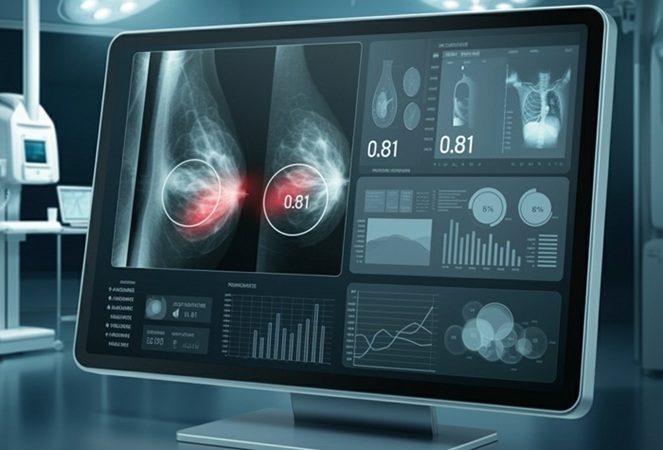Artificial Neural Network Improves Prostate Cancer Detection
|
By MedImaging International staff writers Posted on 29 Apr 2019 |

Image: New research hints that AI may soon make radiologists redundant (Photo courtesy of 123rf.com).
A new artificial intelligence (AI) system identifies and predicts the aggressiveness of prostate cancer (PC) at the same level of accuracy as experienced radiologists.
Developed at the University of California, Los Angeles (UCLA; USA), FocalNet is a convolutional neural network (CNN) that uses an algorithm with more than a million trainable variables. The CNN was trained using multi-parametric MRI (mp-MRI) scans of 417 men with PC prior to robotic-assisted laparoscopic prostatectomy (RALP). In order to learn how to classify the aggressiveness of the tumor using the Gleason score (GS), the results were compared to the actual pathology specimen. They then compared the AI system's results with readings by UCLA radiologists who had more than 10 years of experience.
The results revealed that in the free-response receiver operating characteristics (FROC) analysis for lesion detection, FocalNet showed 89.7% and 87.9% sensitivity for index lesions and clinically significant lesions, respectively. With the comparison to the prospective performance of radiologists using current diagnostic guidelines, FocalNet demonstrated a detection sensitivity for clinically significant lesions (80.5%) comparable to that of radiologists with at least 10 years of experience (83.9%). The study was presented at the IEEE International Symposium on Biomedical Imaging (ISBI), held during April 2019 in Venice (Italy).
“Multi-parametric MRI is considered the best non-invasive imaging modality for diagnosing prostate cancer. However, mp-MRI for PC diagnosis is currently limited by the qualitative or semi-quantitative interpretation criteria, leading to inter-reader variability and a suboptimal ability to assess lesion aggressiveness,” concluded senior author Kyunghyun Sung, of the UCLA department of radiology, and colleagues. “CNNs are a powerful method to automatically learn the discriminative features for various tasks, including cancer detection.”
CNN’s use a cascade of many layers of nonlinear processing units for feature extraction and conversion, with each successive layer using the output from the previous layer as input to form a hierarchical representation.
Related Links:
University of California, Los Angeles
Developed at the University of California, Los Angeles (UCLA; USA), FocalNet is a convolutional neural network (CNN) that uses an algorithm with more than a million trainable variables. The CNN was trained using multi-parametric MRI (mp-MRI) scans of 417 men with PC prior to robotic-assisted laparoscopic prostatectomy (RALP). In order to learn how to classify the aggressiveness of the tumor using the Gleason score (GS), the results were compared to the actual pathology specimen. They then compared the AI system's results with readings by UCLA radiologists who had more than 10 years of experience.
The results revealed that in the free-response receiver operating characteristics (FROC) analysis for lesion detection, FocalNet showed 89.7% and 87.9% sensitivity for index lesions and clinically significant lesions, respectively. With the comparison to the prospective performance of radiologists using current diagnostic guidelines, FocalNet demonstrated a detection sensitivity for clinically significant lesions (80.5%) comparable to that of radiologists with at least 10 years of experience (83.9%). The study was presented at the IEEE International Symposium on Biomedical Imaging (ISBI), held during April 2019 in Venice (Italy).
“Multi-parametric MRI is considered the best non-invasive imaging modality for diagnosing prostate cancer. However, mp-MRI for PC diagnosis is currently limited by the qualitative or semi-quantitative interpretation criteria, leading to inter-reader variability and a suboptimal ability to assess lesion aggressiveness,” concluded senior author Kyunghyun Sung, of the UCLA department of radiology, and colleagues. “CNNs are a powerful method to automatically learn the discriminative features for various tasks, including cancer detection.”
CNN’s use a cascade of many layers of nonlinear processing units for feature extraction and conversion, with each successive layer using the output from the previous layer as input to form a hierarchical representation.
Related Links:
University of California, Los Angeles
Latest General/Advanced Imaging News
- New Ultrasmall, Light-Sensitive Nanoparticles Could Serve as Contrast Agents
- AI Algorithm Accurately Predicts Pancreatic Cancer Metastasis Using Routine CT Images
- Cutting-Edge Angio-CT Solution Offers New Therapeutic Possibilities
- Extending CT Imaging Detects Hidden Blood Clots in Stroke Patients
- Groundbreaking AI Model Accurately Segments Liver Tumors from CT Scans
- New CT-Based Indicator Helps Predict Life-Threatening Postpartum Bleeding Cases
- CT Colonography Beats Stool DNA Testing for Colon Cancer Screening
- First-Of-Its-Kind Wearable Device Offers Revolutionary Alternative to CT Scans
- AI-Based CT Scan Analysis Predicts Early-Stage Kidney Damage Due to Cancer Treatments
- CT-Based Deep Learning-Driven Tool to Enhance Liver Cancer Diagnosis
- AI-Powered Imaging System Improves Lung Cancer Diagnosis
- AI Model Significantly Enhances Low-Dose CT Capabilities
- Ultra-Low Dose CT Aids Pneumonia Diagnosis in Immunocompromised Patients
- AI Reduces CT Lung Cancer Screening Workload by Almost 80%
- Cutting-Edge Technology Combines Light and Sound for Real-Time Stroke Monitoring
- AI System Detects Subtle Changes in Series of Medical Images Over Time
Channels
Radiography
view channel
AI Algorithm Uses Mammograms to Accurately Predict Cardiovascular Risk in Women
Cardiovascular disease remains the leading cause of death in women worldwide, responsible for about nine million deaths annually. Despite this burden, symptoms and risk factors are often under-recognized... Read more
AI Hybrid Strategy Improves Mammogram Interpretation
Breast cancer screening programs rely heavily on radiologists interpreting mammograms, a process that is time-intensive and subject to errors. While artificial intelligence (AI) models have shown strong... Read moreMRI
view channel
AI-Assisted Model Enhances MRI Heart Scans
A cardiac MRI can reveal critical information about the heart’s function and any abnormalities, but traditional scans take 30 to 90 minutes and often suffer from poor image quality due to patient movement.... Read more
AI Model Outperforms Doctors at Identifying Patients Most At-Risk of Cardiac Arrest
Hypertrophic cardiomyopathy is one of the most common inherited heart conditions and a leading cause of sudden cardiac death in young individuals and athletes. While many patients live normal lives, some... Read moreUltrasound
view channel
Non-Invasive Ultrasound-Based Tool Accurately Detects Infant Meningitis
Meningitis, an inflammation of the membranes surrounding the brain and spinal cord, can be fatal in infants if not diagnosed and treated early. Even when treated, it may leave lasting damage, such as cognitive... Read more
Breakthrough Deep Learning Model Enhances Handheld 3D Medical Imaging
Ultrasound imaging is a vital diagnostic technique used to visualize internal organs and tissues in real time and to guide procedures such as biopsies and injections. When paired with photoacoustic imaging... Read moreNuclear Medicine
view channel
PET Tracer Enables Same-Day Imaging of Triple-Negative Breast and Urothelial Cancers
Triple-negative breast cancer (TNBC) and urothelial bladder carcinoma (UBC) are aggressive cancers often diagnosed at advanced stages, leaving limited time for effective treatment decisions.... Read more
New Camera Sees Inside Human Body for Enhanced Scanning and Diagnosis
Nuclear medicine scans like single-photon emission computed tomography (SPECT) allow doctors to observe heart function, track blood flow, and detect hidden diseases. However, current detectors are either... Read more
Novel Bacteria-Specific PET Imaging Approach Detects Hard-To-Diagnose Lung Infections
Mycobacteroides abscessus is a rapidly growing mycobacteria that primarily affects immunocompromised patients and those with underlying lung diseases, such as cystic fibrosis or chronic obstructive pulmonary... Read moreImaging IT
view channel
New Google Cloud Medical Imaging Suite Makes Imaging Healthcare Data More Accessible
Medical imaging is a critical tool used to diagnose patients, and there are billions of medical images scanned globally each year. Imaging data accounts for about 90% of all healthcare data1 and, until... Read more
Global AI in Medical Diagnostics Market to Be Driven by Demand for Image Recognition in Radiology
The global artificial intelligence (AI) in medical diagnostics market is expanding with early disease detection being one of its key applications and image recognition becoming a compelling consumer proposition... Read moreIndustry News
view channel
GE HealthCare and NVIDIA Collaboration to Reimagine Diagnostic Imaging
GE HealthCare (Chicago, IL, USA) has entered into a collaboration with NVIDIA (Santa Clara, CA, USA), expanding the existing relationship between the two companies to focus on pioneering innovation in... Read more
Patient-Specific 3D-Printed Phantoms Transform CT Imaging
New research has highlighted how anatomically precise, patient-specific 3D-printed phantoms are proving to be scalable, cost-effective, and efficient tools in the development of new CT scan algorithms... Read more
Siemens and Sectra Collaborate on Enhancing Radiology Workflows
Siemens Healthineers (Forchheim, Germany) and Sectra (Linköping, Sweden) have entered into a collaboration aimed at enhancing radiologists' diagnostic capabilities and, in turn, improving patient care... Read more




















